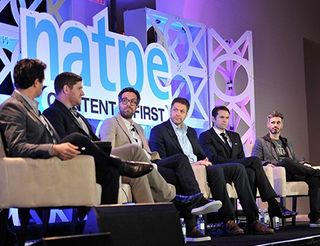As the Bundle Shrinks in Linear TV, OTT Execs See Strength in Numbers

Coming on the heels of CES and traditionally more geared to the syndication and international markets, NATPE isn’t necessarily where you’d expect hardcore tech talk to break out. But recent editions of the show have seen an increasing digital focus. Ted Sarandos, chief content officer at Netflix, made an appearance (though mainly to salute Brandon Tartikoff Legacy Award honorees Norman Lear and Quincy Jones) and companies from Fullscreen to GoPro populated the Fontainebleau Hotel. Throughout its Jan. 19-21 run, the show became the latest venue for the traditional TV industry to grapple with changes in delivery and consumer appetite. One noteworthy panel, somewhat ominously titled “The Rise of New OTT Platforms,” brought together five execs to discuss the ways over-the-top services are both borrowing from and disrupting existing broadcast and cable models. Below are highlights from the conversation, which was moderated by David Freeman, co-head of digital talent and packaging for CAA.
David Freeman:Why are you in the OTT space and what does success look like to you?
Floris Bauer (cofounder and president of Gunpowder & Sky, a new OTT service backed by Chernin Group and cofounded by ex-MTV exec Van Toffler): I have been looking at digital video for the last 10 years or so, from a premium point of view, working at Endemol [Shine Group]. We always struggled with brand partnerships. We maybe did two or three a year. But over the last two years or so we’ve really seen an acceleration in demand for premium. Finally, platforms are paying real money.…The domestic disruption is insane. People talk about publishing and music [being disrupted] but I think TV by far is the biggest opportunity in media today.…These pipes all need to be filled and they need to be filled by premium content.
Jimmy Maymann (president, content and consumer brands, AOL):Our narrative has been desktop-driven. But we live in a world where things are changing very fast. We touch 500 million people on a monthly basis. We have 100 people working in our studio making thousands of video clips every month.…It has been a learning experience. We’ve focused mostly on short-form unscripted content. But with the launch of go90 [with AOL’s new owner, Verizon] we are getting to a point now where we feel we have what it takes to engage that audience and keep them there and potentially over time even create an SVOD model. As go90 continues, what we’ll try to do is have the two things meet.
Evan Shapiro (executive VP of digital enterprises, NBCUniversal): We wanted to investigate and solve a consumer problem. When you look at SVOD and OTT, what you see is something very similar to what broadcast television and the television business looked like in 1978, 1979. Three major players serving all of the people all of the time. What we’ve seen over the years is fragmentation that better serves consumers.…When you’re in the middle of a binge, [Netflix, Hulu and Amazon] are great and having access to a lot of content is great. But if you’re looking for a lean-back experience, if you’re logging on on a Saturday night, let’s say, over a glass of wine…it gets to be work. You can search and search and not find something. That’s because the vast majority of that product is driven by an algorithm and not by a bunch of professional curators trying to serve the needs of the consumer.
Freeman:Ben, why is YouTube Red putting content behind a paywall?
Ben Relles (head of comedy and unscripted, YouTube): I started as a YouTuber myself 10 years ago and as you recall, a lot of it then was people trying to figure out what their channels were going to be. There weren’t a lot of consistent series or consistent channels of specific content.…Now, it felt like a moment when all of our top talent wanted to do more ambitious projects.…We’re looking to enable the kinds of budgets for projects that couldn’t work in our ad-supported environment.
Broadcasting & Cable Newsletter
The smarter way to stay on top of broadcasting and cable industry. Sign up below
Freeman:When we’re at NATPE in 2017, where will OTT be?
Relles: With 360 and VR, we’re starting to see some incredible storytelling. It’s interesting that if you spend enough time at the Fontainebleau, you hear the spiel that ‘TV wants to be digital and digital wants to be TV and it’s all coming together and how do you separate it?’ But it does feel like a year from now or certainly five years from now, there aren’t going to be so many lines between this stuff.…It doesn’t feel like we’re that far off from there being no difference.
Shapiro: One big trend we’re going to see is bundling. We do better selling en masse, as cable learned before. You’re going to see naturally a consumer drive toward, ‘Can I get it all at one stop?’ I don’t have an answer to how that happens, but there are players out in the marketplace who are trying to make that happen and I think the sooner we get to a way the consumer can buy it all at once, it’s going to help all of the platforms, especially the smaller ones.
